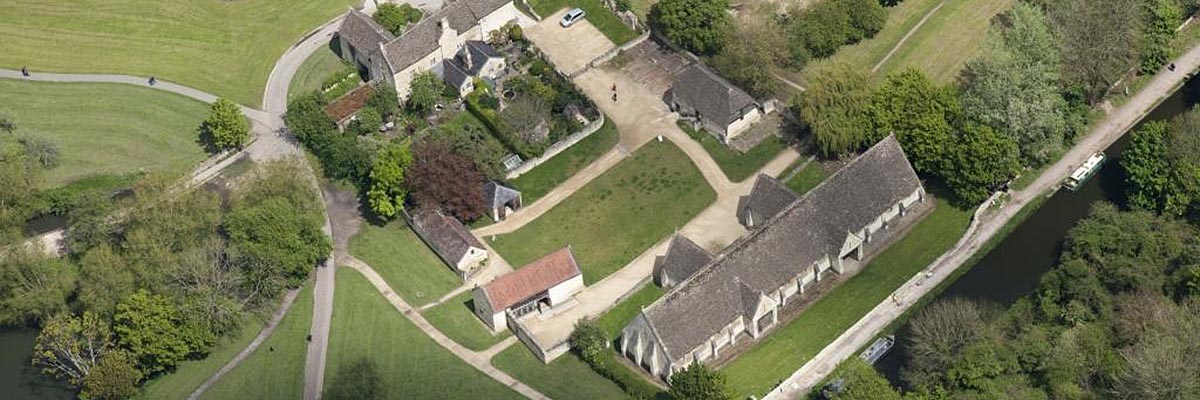Research on Bradford-on-Avon Tithe Barn
Documentary research has shed light on Barton Grange in the Middle Ages, and a survey from 1914 contains a detailed analysis of the barn. However, excavation work has been concentrated on the farm’s other medieval structures, rather than the tithe barn itself.

Early Research
The first serious record of Bradford-on-Avon Tithe Barn was a measured survey carried out by Sydney Follett in 1908.[1] Other than this, the barn does not seem to have received serious study at any point before its transfer in 1914 to the Wiltshire Archaeological Society.
Harold Brakspear’s survey of the building, made in 1914 for the Society, represented the first structural analysis of the barn and revealed its poor structural condition. No record of this is known other than the report in the Wiltshire Archaeological and Natural History Magazine for 1915–17.[2]
The Ministry of Works carried out major repairs in the 1950s. Despite their complexity and thoroughness, no published record or account of these repairs seems to have been made. The files are held in the National Archives, and plans and photographs in the Historic England Archive (see Sources for Bradford-on-Avon Tithe Barn).
Documentary Research
The most significant documentary research on the history of Barton Grange (the monastic farm of which the barn was part) in the Middle Ages and the role of the tithe barn as part of a monastic agricultural complex is that carried out by Robert and Barbara Harvey from the late 14th-century accounts of Shaftesbury Abbey.[3]
Robert Harvey carried out further research into the history of the town in the 12th century from evidence in the Cartulary of Shaftesbury Abbey,[4] but this does not bear directly on Barton Grange, and pre-dates the building of the barn.
The early charters from the cartulary, which were published in 1996 and 2006, may shed further light on the history of Bradford-on-Avon in the Middle Ages.[5]
Excavations
Excavations were carried out in 1983 by volunteers, directed by Jeremy Haslam, to examine the remains of the medieval west barn next to the tithe barn.[6] These investigations were prompted following a fire in 1982 which destroyed this barn’s stable wing (see Description of Bradford-on-Avon Tithe Barn). The excavation established the plan of the original barn. The cross-wing, running east–west, is thought to have been formed of two large porches.
Haslam suggested that this barn might have been used as a cowshed, and could have been built in the same period as the great barn as part of a planned agricultural complex.
Further excavation work was carried out between 1998 and 2003 in advance of the restoration of the west barn. This developed our understanding of the agricultural development of the site – evidence was found of two successive limestone pavements, suggesting that the west barn was built on the site of a larger, earlier barn.[7]
READ MORE ABOUT BRADFORD-ON-AVON TITHE BARN
Footnotes
1. Historic England Archive, MD71/00176.
2. AWN Burder, ‘The mediaeval tithe barn, Bradford-on-Avon: report on the work of repair’, Wiltshire Archaeological and Natural History Magazine, 39 (1915–17), 485–90 (accessed 13 Nov 2015).
3. Swindon and Wiltshire History Centre, 1742/6786; R Harvey and B Harvey, ‘Bradford-on-Avon in the 14th century’, Wiltshire Archaeological and Natural History Magazine, 86 (1993), 118–29 (accessed 13 Nov 2015).
4. R Harvey, ‘Shaftesbury Abbey’s 12th-century rentals for Bradford-on-Avon’, Wiltshire Archaeological and Natural History Magazine, 91 (1998), 76–89 (accessed 13 Nov 2015).
5. SE Kelly (ed), Charters of Shaftesbury Abbey (Oxford, 1996); NE Stacy (ed), Charters and Custumals of Shaftesbury Abbey, 1089–1216 (Oxford, 2006).
6. J Haslam, ‘Excavations at Barton Farm, Bradford-on-Avon, 1983: interim report’, Wiltshire Archaeological and Natural History Society Magazine, 78 (1984), 120–21 (accessed 13 Nov 2015).
7. M Heaton and W Moffatt, ‘Recent work at Barton Grange Farm, Bradford-on-Avon’, Wiltshire Archaeological and Natural History Society Magazine, 97 (2004), 211–17 (accessed 13 Nov 2015).